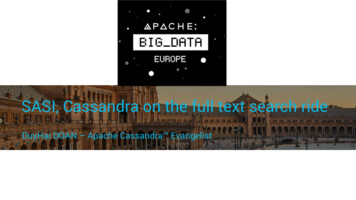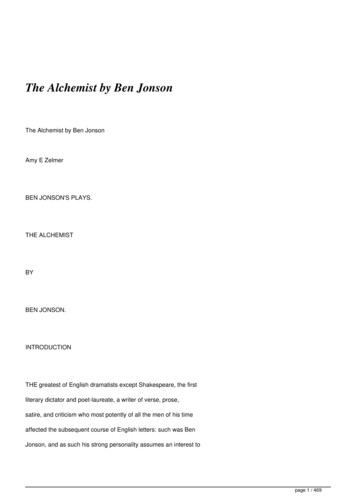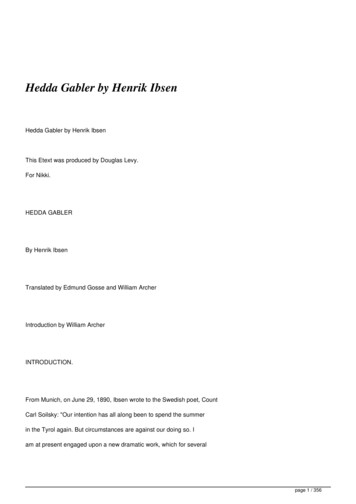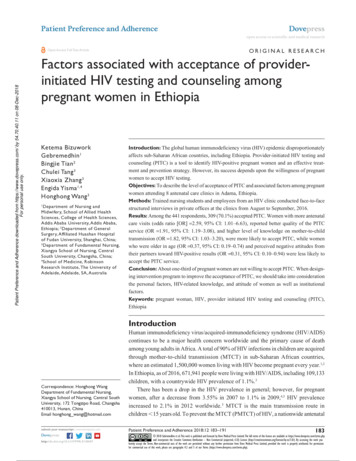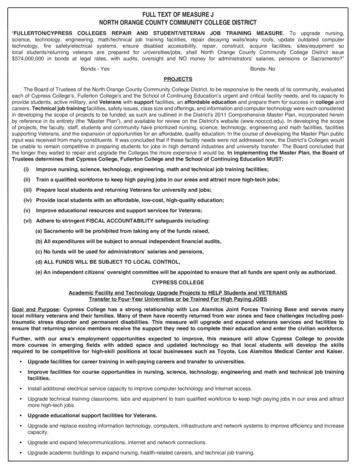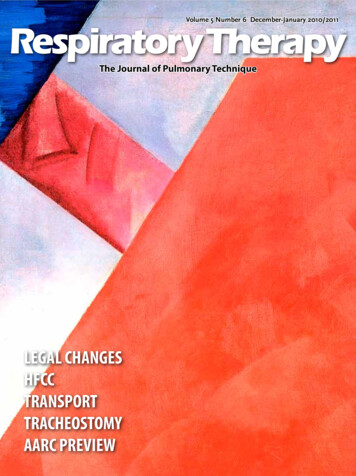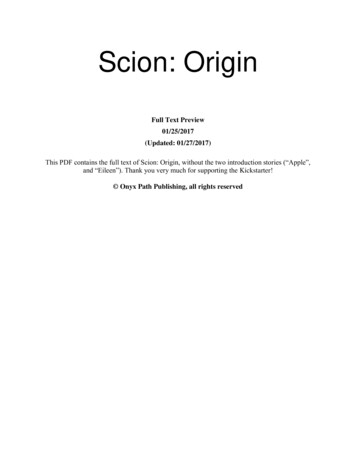
Transcription
Scion: OriginFull Text Preview01/25/2017(Updated: 01/27/2017)This PDF contains the full text of Scion: Origin, without the two introduction stories (“Apple”,and “Eileen”). Thank you very much for supporting the Kickstarter! Onyx Path Publishing, all rights reserved
Introduction“Believe what?” asked Shadow. “What should I believe?”“Everything,” roared the buffalo man.— American GodsFairy tales say that apples were golden only to refresh the forgotten momentwhen we found that they were green. They make rivers run with wine only to makeus remember, for one wild moment, that they run with water.— GK ChestertonThe ancient powers never fully went away. They wander our roads and cities, mingling with theteeming masses of humanity. You are one of their children, born to the magic of yesterday andthe promise of tomorrow. Ichor surges through your veins, thick and golden. Divine weaponsrest in your palm, Godly power begging to be released. Across the World entire, masses chantyour name in reverence — and elsewhere, utter it as a spiteful curse. Gods array themselvesagainst you, or stand beside you.Your ancient enemies, the Titans, stir in their prison beneath the lands of the dead. Their spawnissues forth from lands of myth, and the specter of war falls across the heavens. Titanomachy.Into this age of turmoil, you seize your birthrights and feel the call of your blood. Family hasbrought you here, and heroism will take you to your end, whatever that may be.You live in a World of myth, where every ancient story is true. Beneath the shadow of gleamingskyscrapers and soaring jets, the old tales are whispered. Will you live in a World of omens andportents, fearful of the shadows upon the sky? Or will you rise up, claim what is yours, and livefor the people below?Find your destiny. Live the myth. Embrace your Fate.[PLEASE CENTER THESE ASTERISKS]***Scion is a game about Gods and humanity, and everything in between. It’s a game about mythicDeeds and the reasons people talk about those mythic Deeds. It’s also about modernity — theWorld today is a very different place than the anything our ancestors could have conceived.Scion encompasses four core books — Origin, Hero, Demigod, and God — defining andexpanding the setting and some of the primary pantheons or groups of Gods. They also detail theprimary player character type (Scions) climbing in power and Legend until they’re Godsthemselves.Origin details the Scions when they’re still (mostly) human, before the Visitation that introducesthem to the divine World — they’re exceptional humans, perhaps, blessed with luck and skill orcursed with ill fortune and strange trials in their lives, but humans nonetheless. The book detailsthe system and setting of Scion, and includes rules and information on the various denizens andLegendary Creatures. The World of Origin is one much like our own, with strangeness and thehand of the Gods made subtle. The pre-Visitation Scions, denizens, and offspring of Legends inOrigin inhabit a World of signs and portents, making their way through strange, arcane, andhigh-octane adventures.
Their stories are archetypal, allegorical, less literal but no less important than their parents andantecedents. While their adventures are more figurative, pre-Visitation Scions and the Denizensof the World live out their lives in a grand tableau set against the backdrop of myth and legend,grounded in the real world of small people and grand schemes.ThemesScion depicts the titular Scions, human beings who are the children of Gods, whether literally ormetaphorically, who inhabit a World of divine symbolism and mythic resonance. The World ismodern, full of technology and a rich mixture of culture that past societies could scarcely dreamof, yet the ancient mores and stories hold immortal truths to those who would listen and relivethem. The more power and Legend Scions build, the greater their Boons and Birthrights, divinemiracles and Godly gifts, build alongside them. The more the Scion grows in might, the moreesoteric their existence becomes, until they choose to plateau within mortality or leave theirhumanity behind entirely. Scions venture alongside Legendary Creatures, centaurs and kitsuneand stranger denizens, exploring their World, reliving the stories of their parents, and creatingnew stories.Belief in the old Gods still runs strong in the World. In the World, the old Gods are still here, inspirit and in fact. Their religions were never overtaken by monotheism to the extent they were inour world, though some weathered the storm better than others. Cults and temples hold a farsmaller place alongside prayer groups and churches, but they’re there, in greater numbers andwith greater acceptance. Stranger things persist in the cracks of the World, lurking ever withinhumanity’s collective peripheral vision: colonies of satyrs in the mountains of Greece, fightingfor territory with the centaurs who still lope across the plains of Thessaly, where there are so fewcameras. Tengu nestle among Japanese skyscrapers, conducting secret business with the selectfew they admit to see them. In the American West, a different kind of centaur rides the highwayson two wheels, chrome where human legs should be and oil pumping in their hearts. The Worldof Legend exists alongside the World of humanity, creating a continuous line from ancient tomodern mythology. A Greek woman, an Amazon, calls up her Nordic valkyrie and Dahomeanwarrior-woman best friends, and the three tear up the New York bar scene.You can still go to a library and read the ancient stories about the Gods. You can research themon the internet. Scion’s World is one of manifest myth.In ancient times, the Gods interfered in human lives more directly, letting verdant fields andvictory in battle voice their blessings upon mankind while rampaging beasts, natural disasters,plague, and famine spoke of their displeasure. The spawn of the Titans, dread progenitors of theGods and cruel embodiments of the nature of the World, often lurked just outside civilization,ready to devour hapless mortals who stopped at the wrong spring to drink or took the wrongpaths through the dark, deep woods.It was to Scions that humanity looked for protection from supernatural predation, and it wasScions who often interceded with the Gods on humanity’s behalf. Scions flattered their parents,moved them to feel pity, or offered their services if the divine would spare their wrath. In themodern day, humanity has tamed all but the most remote or dangerous areas of the mortal World,but even now the World holds great power. The Titans stir in 1,000 prisons, agitating for theirreturn and the unleashing of their monstrous titanspawn. Together, they represent a threat beyondthe ken of modern man. Only the Scions are equipped to deal with such threats, and are againfilling their ancient role of guardians of man and human civilization.
RelationshipsNo stories exist in a vacuum. Who you are is very much tied to who you are to other people.Scions are bound and (somewhat) defined by their relationships. It’s in the name of the game:being a scion means you’re from a greater parent, which itself defines your identity by relation tosomeone or something else. Scions exist in stories by themselves, but their Legend also grows inrelation to other myths and beings: Thor has stories about himself, but also about himadventuring with Tyr and Loki and even Odin.Modern MythsMyths enact the cultural and political values of their time, generally intended to preserve thosevalues; modern Scions can either accept or reject those cultural mores. Scions belong to ancientcultures that exist in the modern day, but they’re also products of the modern World, and theymust use old wisdom to navigate new horizons. Modern thinking and morality clashing withancient mores, and the audacity to change the World will define a Scion’s character.Myths in the Modern DayLeslie Poles Hartley once noted that “the past is a foreign country; they do things differentlythere.” The myths of Scion are ancient stories accessible to the characters, just as they are to us,but they’re also things that happened.If you’re a male or genderfluid Scion of the Æsir, is your masculinity defined by the magics youperform? Even Odin All-Father gets shit from Loki for practicing seiðr, the Norse fate-magicconsidered to be a womanly art. Do you bow to social pressure, or do you tell Thor to choke onhis hammer because you’ll wear a dress if you feel like it and magic all day long? And this goesway beyond the Norse. The Greek Gods took mortals by force, and perhaps they still do. TheAztecs once expected blood, or the sun would not rise. What does it mean to confront this sort ofthing head on, these belief systems, in a modern context?MoodsA mood of heroism, of greatness and grandeur, should suffuse your games, for a Scion cannothelp but be great in some manner, and inevitably find themselves venerated by culture. Everymyth cycle is, at the heart, a story told by real humans to inspire, caution, and explain the waywe think and believe. At the core of those myth cycles are the heroes, the figures whose virtuesand flaws are larger than life.Reverence is also a critical mood, because these are (or at least were) real faiths we’re talkingabout, even if it’s in a fictional environment. Between the heaving of cars at one’s foes and thevisceral thrill of immortals making love, there is gravitas and seriousness, for myths are apeople’s way of knowing themselves and who they are. Reverence for the grandeur and passionof these stories is critical. Not passion in the sense of “slaking one’s lusts,” but passion in thesense of a mythic heart and intense feeling. No Scion is a wallflower; even the ones whodisappear from the World do so with great pathos and tinged sadness.How to Use this BookScion: Origin is the companion book to Scion: Hero and the core book of the Scion SecondEdition line. This book will teach you about the basic setting of Scion (called the World), themajor players (Gods and Titans), and how to make characters, including the children of Gods
who haven’t yet realized their divine power. Scion: Hero will allow you to make characters whohave adopted their heritage and stepped into the World of myth fully and completely.An Introduction to Storytelling GamesIn all likelihood, you know what a storytelling — or roleplaying — game is already. But ifyou’re new here, let’s talk about the basics:In Scion, you play out stories following a core cast of characters as they make their way in aWorld that’s a mix of the everyday things we know and the mythology that sits dusty in libraries,is retold lovingly from parent to child, repeated across blog posts, or permeates our pop culture.It’s a lot like a TV series, and individual gaming sessions (which generally run two to four hours)are like weekly episodes. Over the course of multi-episode story arcs stretching into seasons,secrets will be revealed, relationships will be tested, and myths will be forged.Around two to five players take on the role of one character each. You’ll make decisions for yourcharacter. When her divine parents ignore her and the mortal cultists give her guff, you’ll decidewhether she tries to keep communicating with them or smack down the truculent hierophant.When Titanspawn affect her existence, you’ll decide whether she runs, prays, or seeks toimmerse herself deeper within the World of myth. Most importantly, you’ll tell the story of hergoing along with, or struggling against, the power of Fate and narrative that underlies her entireexistence.One player, the Storyguide, is responsible for portraying characters who don’t belong to specificplayers and presenting fictional situations that challenge the other players’ characters. Think ofthe Storyguide as the director guiding the supporting cast of the TV series — both ongoingcharacters who help or oppose the core cast, and guest stars of the week who turn up to causeunique kinds of trouble. They’re not the ones who make the show, or even the stars, but withoutthem the show is far lesser.As for challenging the player characters, it’s the job of the Storyguide to come up with sceneswhere the players must make decisions fraught with conflict and danger. The Storyguide narratesa situation, then the other players say how their characters respond. The most important questiona Storyguide can ask is “What do you do now?”When a character acts, the outcome of the action is determined by rolling a handful of dice. Thebasics are simple. You add a few numbers on your character sheet (a miniature dossier) and rollthat many dice. You’ll find out whether your action works and progresses the story, or fails andgets your character into more trouble.While players other than the Storyguide will generally be advocates for their characters’ success,planning ways in which they can succeed, a lot of drama and fun comes from when things don’tgo well for the protagonists. Again, think of a television series the most interesting episodes areoften the ones where everything goes wrong for the characters until they find a way to turn itaround. That said, the Storyguide should make sure characters have a chance to bounce backrather than constantly dumping suffering on them.The players are responsible for: creating and playing their own individual characters,occasionally playing other members of the cast, making decisions that spur on drama and keepthe story moving, highlighting their characters’ mythology-based strengths and weaknesses,ceding the spotlight when it’s another player’s time to shine, engaging the story the Storyguide
introduces, and developing their characters’ personalities and abilities over time to tell personalstories within the overall narrative of the game.The Storyguide is responsible for: bringing the World to life through narrative description,deciding where scenes start and end, portraying non-player characters, involving each p
Scion: Origin Full Text Preview 01/25/2017 (Updated: 01/27/2017) This PDF contains the full text of Scion: Origin, without the two introduction stories (“Apple”,
